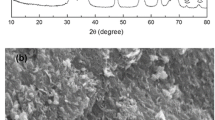Abstract
In recent years there is progressive research conducted on modification of textile and nanoparticles for long-lasting performances without compromising the sensorial and non-sensorial comfort. The appropriate finishing treatment of textile is of great concern to impart comfort along with durable multifunctional characters. The main objective of this study was to achieve the durable functionality without compromising the comfort and physical properties of cotton fabric. TiO2 nanoparticles have been modified with two different silane coupling agents such as (3-Glycidoxypropyl)trimethoxysilane (GPTS) and 1,2-Bis(triethoxysilyl)ethane (BTSE) using different concentrations. The modified nanoparticles were characterized using Scanning electron microscopy (SEM), Fourier-transform infrared spectroscopy (FTIR), thermogravimetric analysis (TGA) to confirm the modification and fixing of chemicals at the surface. Modified nanoparticles were applied on textile by pad-dry-cure method. The treated cotton fabrics were washed to confirm the adhesion of nanoparticles after several washing cycles. The durable ultraviolet (UV) blocking capabilities were analyzed before and after washing. Then, comfort properties were evaluated and compared to made selection of best silane coupling agent having minimum effect on inherent properties of cotton textiles.
Similar content being viewed by others
References
M. Radetić, J. Mater. Sci., 48, 95 (2013).
A. G. Gonçalves, B. Jarrais, C. Pereira, J. Morgado, C. Freire, and M. F. R. Pereira, J. Mater. Sci., 47, 5263 (2012).
M. Yu, C. Gu, W.-D. Meng, and F.-L. Qing, Appl. Surf. Sci., 253, 3669 (2007).
C.-H. Xue, S.-T. Jia, H.-Z. Chen, and M. Wang, Sci. Technol. Adv. Mater., 9, 035001 (2008).
S. Riaz, M. Ashraf, T. Hussain, and M. T. Hussain, Cellulose, 26, 5159 (2019).
S. Riaz, M. Ashraf, T. Hussain, M. T. Hussain, and A. Younus, Colloids Surfaces A Physicochem. Eng. Asp., 581, 123799 (2019).
K. Qi, J. H. Xin, W. A. Daoud, and C. L. Mak, Int. J. Appl. Ceram. Technol., 4, 554 (2007).
A. Mickevičiene, D. Mikučioniene, and L. Rageliene, Fibres Text. East. Eur., 5, 59 (2014).
E. Navarro, A. Baun, R. Behra, N. B. Hartmann, J. Filser, A. J. Miao, A. Quigg, P. H. Santschi, and L. Sigg, Ecotoxicology, 17, 372 (2008).
E. S. Bernhardt, B. P. Colman, M. F. Hochella, B. J. Cardinale, R. M. Nisbet, C. J. Richardson, and L. Yin, J. Environ. Qual., 39, 1954 (2010).
P. Limpiteeprakan, S. Babel, J. Lohwacharin, and S. Takizawa, Environ. Sci. Pollut. Res., 23, 22810 (2016).
L. Windler, C. Lorenz, N. von Goetz, K. Hungerbühler, M. Amberg, M. Heuberger, and B. Nowack, Environ. Sci. Technol., 46, 8181 (2012).
R. Dastjerdi, M. Montazer, and S. Shahsavan, Colloids Surf A Physicochem Eng Asp., 345, 202 (2009).
J. Sójka-Ledakowicz and M. H. Kudzin, Fibres Text East Eur., 22, 118 (2014).
A. Yadav, V. Prasad, A. A. Kathe, S. Raj, D. Yadav, C. Sundaramoorthy, and N. Vigneshwaran, Bull. Mater. Sci., 29, 641 (2006).
L. W. McKeen, “Fluorinated Coatings Finish”, 2nd Ed., William Andrew Publishing, New York, 2006.
I. Khan, K. Saeed, and I. Khan, Arab. J. Chem., 12, 908 (2019).
D. R. Baer, M. H. Engelhard, G. E. Johnson, J. Laskin, J. Lai, K. Mueller, P. Munusamy, S. Thevuthasan, H. Wang, N. Washton, A. Elder, B. L. Baisch, A. Karakotti, S. V. N. T. Kuchibhatla, and D. Moon, J. Vac. Sci. Technol. A, 31, 050820 (2013).
A. Amaria, N. Nuryono, and S. Suyanta, Orient. J. Chem., 33, 384 (2017).
J. Zhao, M. Milanova, M. M. C. G. Warmoeskerken, and V. Dutschk, Colloids Surfaces A Physicochem. Eng. Asp., 413, 273 (2012).
Y. Yin, R. Huang, Y. Xu, and C. Wang, J. Text. Inst., 108, 1662 (2017).
M. P. Fuller and P. R. Griffiths, Anal. Chem., 50, 1906 (1978).
E. Ukaji, T. Furusawa, M. Sato, and N. Suzuki, Appl. Surf. Sci., 254, 563 (2007).
J. Coates in “Encyclopedia of Analytical Chemistry” (R. A. Meyers Ed.), Vol. 6, pp.10815–10837, John Wiley & Sons, New York, 2000.
Y. Buyukmurat and S. Akyuz, J. Mol. Struct., 744–747, 921 (2005).
S. B. Stankovic, D. Popovic, G. B. Poparic, and M. Bizjak, Text. Res. J., 79, 1034 (2009).
H. Yang, S. Zhu, and N. Pan, J. Appl. Polym. Sci., 92, 3201 (2004).
N. Abidi, L. Cabrales, and E. Hequet, ACS Appl. Mater. Interfaces, 1, 2141 (2009).
M. Yang, W. Liu, C. Jiang, C. Liu, S. He, Y. Xie, and Z. Wang, J. Mater. Sci., 54, 2079 (2019).
N. A. Ibrahim, B. M. Eid, E. A. El-Aziz, T. M. Abou Elmaaty, and S. M. Ramadan, RSC Adv., 7, 33219 (2017).
K. Hoffmann, J. Laperre, A. Avermaete, P. Altmeyer, and T. Gambichler, Arch. Dermato., 137, 1089 (2001).
Acknowledgement
This work was supported by the Higher Education Commission of Pakistan [NRPU Grant No. 6074].
Author information
Authors and Affiliations
Corresponding author
Rights and permissions
About this article
Cite this article
Riaz, S., Ashraf, M., Hussain, T. et al. Selection and Optimization of Silane Coupling Agents to Develop Durable Functional Cotton Fabrics Using TiO2 Nanoparticles. Fibers Polym 22, 109–122 (2021). https://doi.org/10.1007/s12221-021-9245-4
Received:
Revised:
Accepted:
Published:
Issue Date:
DOI: https://doi.org/10.1007/s12221-021-9245-4




